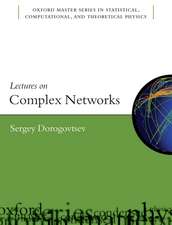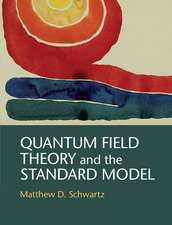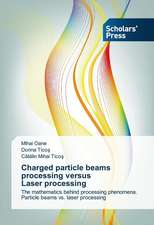Quantum Field Theory I: Foundations and Abelian and Non-Abelian Gauge Theories: Graduate Texts in Physics
Autor Edouard B. Manoukianen Limba Engleză Hardback – 13 dec 2016
Particular emphasis is placed on the concept of a quantum field and its particle content to provide an appropriate description of physical processes at high energies, where relativity becomes indispensable. Moreover, quantum mechanics implies that a wave function renormalization arises in the QFT field independent of any perturbation theory - a point not sufficiently emphasized in the literature. The book provides an overview of all the fields encountered in present high-energy physics, together with the details of the underlying derivations. Further, it presents “deep inelastic” experiments as a fundamental application of quantum chromodynamics.
Though the author makes a point of deriving points in detail, the book still requires good background knowledge of quantum mechanics, including the Dirac Theory, as well as elements of the Klein-Gordon equation. The present volume sets the language, the notation and provides additional background for reading Quantum Field Theory II - Introduction to Quantum Gravity, Supersymmetry and String Theory, by the same author. Students in this field might benefit from first reading the book Quantum Theory: A Wide Spectrum (Springer, 2006), by the same author.
| Toate formatele și edițiile | Preț | Express |
|---|---|---|
| Paperback (1) | 505.65 lei 43-57 zile | |
| Springer International Publishing – 4 iul 2018 | 505.65 lei 43-57 zile | |
| Hardback (1) | 605.70 lei 43-57 zile | |
| Springer International Publishing – 13 dec 2016 | 605.70 lei 43-57 zile |
Din seria Graduate Texts in Physics
- 15%
 Preț: 535.34 lei
Preț: 535.34 lei - 20%
 Preț: 570.35 lei
Preț: 570.35 lei - 15%
 Preț: 599.14 lei
Preț: 599.14 lei - 13%
 Preț: 358.24 lei
Preț: 358.24 lei - 20%
 Preț: 695.17 lei
Preț: 695.17 lei - 17%
 Preț: 494.61 lei
Preț: 494.61 lei - 17%
 Preț: 461.36 lei
Preț: 461.36 lei - 15%
 Preț: 652.31 lei
Preț: 652.31 lei -
 Preț: 178.06 lei
Preț: 178.06 lei - 17%
 Preț: 495.92 lei
Preț: 495.92 lei - 15%
 Preț: 368.63 lei
Preț: 368.63 lei -
 Preț: 276.40 lei
Preț: 276.40 lei - 20%
 Preț: 700.72 lei
Preț: 700.72 lei - 17%
 Preț: 528.36 lei
Preț: 528.36 lei - 8%
 Preț: 503.58 lei
Preț: 503.58 lei - 17%
 Preț: 399.28 lei
Preț: 399.28 lei - 17%
 Preț: 461.49 lei
Preț: 461.49 lei -
 Preț: 360.95 lei
Preț: 360.95 lei -
 Preț: 456.10 lei
Preț: 456.10 lei - 20%
 Preț: 762.14 lei
Preț: 762.14 lei - 15%
 Preț: 478.38 lei
Preț: 478.38 lei - 20%
 Preț: 637.50 lei
Preț: 637.50 lei - 15%
 Preț: 483.15 lei
Preț: 483.15 lei - 15%
 Preț: 649.22 lei
Preț: 649.22 lei -
 Preț: 456.10 lei
Preț: 456.10 lei -
 Preț: 421.23 lei
Preț: 421.23 lei -
 Preț: 404.13 lei
Preț: 404.13 lei - 15%
 Preț: 667.86 lei
Preț: 667.86 lei - 15%
 Preț: 724.80 lei
Preț: 724.80 lei - 15%
 Preț: 598.83 lei
Preț: 598.83 lei -
 Preț: 388.72 lei
Preț: 388.72 lei - 19%
 Preț: 460.09 lei
Preț: 460.09 lei - 15%
 Preț: 601.60 lei
Preț: 601.60 lei -
 Preț: 397.59 lei
Preț: 397.59 lei -
 Preț: 455.89 lei
Preț: 455.89 lei - 15%
 Preț: 534.28 lei
Preț: 534.28 lei - 18%
 Preț: 753.83 lei
Preț: 753.83 lei - 15%
 Preț: 602.42 lei
Preț: 602.42 lei - 15%
 Preț: 596.69 lei
Preț: 596.69 lei -
 Preț: 403.75 lei
Preț: 403.75 lei - 15%
 Preț: 529.45 lei
Preț: 529.45 lei - 15%
 Preț: 640.88 lei
Preț: 640.88 lei -
 Preț: 372.81 lei
Preț: 372.81 lei -
 Preț: 501.61 lei
Preț: 501.61 lei
Preț: 605.70 lei
Preț vechi: 712.59 lei
-15% Nou
Puncte Express: 909
Preț estimativ în valută:
115.94€ • 125.98$ • 97.45£
115.94€ • 125.98$ • 97.45£
Carte tipărită la comandă
Livrare economică 21 aprilie-05 mai
Preluare comenzi: 021 569.72.76
Specificații
ISBN-13: 9783319309385
ISBN-10: 3319309382
Pagini: 540
Ilustrații: XX, 586 p. 77 illus.
Dimensiuni: 155 x 235 x 40 mm
Greutate: 1.02 kg
Ediția:1st ed. 2016
Editura: Springer International Publishing
Colecția Springer
Seria Graduate Texts in Physics
Locul publicării:Cham, Switzerland
ISBN-10: 3319309382
Pagini: 540
Ilustrații: XX, 586 p. 77 illus.
Dimensiuni: 155 x 235 x 40 mm
Greutate: 1.02 kg
Ediția:1st ed. 2016
Editura: Springer International Publishing
Colecția Springer
Seria Graduate Texts in Physics
Locul publicării:Cham, Switzerland
Cuprins
Acknowledgements.- Preface to Volume I.- Notation and Data.- Introduction.- Preliminaries.- Quantum Field Theory Methods of Spin 1/2.- Fundamental Aspects of Quantum Field Theory.- Abelian Gauge Theories.- Non- Abelian Gauge Theories.- Appendix I: The Dirac Formalism.- Appendix II: Doing Intergals in Field Theory.- Appendix III: Analytic Continuation in Spacetime Dimension and Dimensional Regulation.- Appendix IV: Schwinger’s Point Splitting Method of Currents: Arbitrary Orders.- Appendix V: Renormalization and the Underlying Subtractions.- Solutions to the Problems.- Index.
Recenzii
“A very valuable feature of the book is the discussion of many topics, sometimes skipped in quantum field theory books, as well as the explicit and detailed discussion of many applications of quantum field theory to important physical processes. … The book closes with appendices, useful for explicit computations, and with the solutions of the problems proposed in the text.” (zbMATH, Vol. 1366.81001, 2017)
Notă biografică
Professor Dr. Edouard B. Manoukian, currently professor at The Institute for Fundamental Study (IF), Naresuan University, Phitsanulok, Thailand, received his M.Sc. and Ph.D. degrees in 1968 and 1971, from McGill and University and the University of Toronto, Canada, respectively. He was a researcher at the Theoretical Physics Institute of the University of Alberta, the Dublin Institute for Advanced Studies, and the Centre de Recherches Mathématiques Appliquées of the University of Montreal. In 1978 he joined the staff of the Department of National Defense of the Royal Military College of Canada and was appointed as a full professor in 1985. He has authored several books, two of which with Springer, and he has published over 190 research papers on many aspects of theoretical physics.
Textul de pe ultima copertă
This textbook covers a broad spectrum of developments in QFT, emphasizing those aspects that are now well consolidated and for which satisfactory theoretical descriptions have been provided. The book is unique in that it offers a new approach to the subject and explores many topics merely touched upon, if covered at all, in standard reference works.
A detailed and largely non-technical introductory chapter traces the development of QFT from its inception in 1926. The elegant functional differential approach put forward by Schwinger, referred to as the quantum dynamical (action) principle, and its underlying theory are used systematically in order to generate the so-called vacuum-to-vacuum transition amplitude of both abelian and non-abelian gauge theories, in addition to Feynman’s well-known functional integral approach, referred to as the path-integral approach. Given the wealth of information also to be found in the abelian case, equal importance is put on both abelian and non-abelian gauge theories.
Particular emphasis is placed on the concept of a quantum field and its particle content to provide an appropriate description of physical processes at high energies, where relativity becomes indispensable. Moreover, quantum mechanics implies that a wave function renormalization arises in the QFT field independent of any perturbation theory - a point not sufficiently emphasized in the literature. The book provides an overview of all the fields encountered in present high-energy physics, together with the details of the underlying derivations. Further, it presents “deep inelastic” experiments as a fundamental application of quantum chromodynamics.
Though the author makes a point of deriving points in detail, the book still requires good background knowledge of quantum mechanics, including the Dirac Theory, as well as elements of the Klein-Gordon equation. The present volume sets the language, the notation and provides additional background for reading Quantum Field Theory II - Introduction to Quantum Gravity, Supersymmetry and String Theory, by the same author. Students in this field might benefit from first reading the book Quantum Theory: A Wide Spectrum (Springer, 2006), by the same author.
Particular emphasis is placed on the concept of a quantum field and its particle content to provide an appropriate description of physical processes at high energies, where relativity becomes indispensable. Moreover, quantum mechanics implies that a wave function renormalization arises in the QFT field independent of any perturbation theory - a point not sufficiently emphasized in the literature. The book provides an overview of all the fields encountered in present high-energy physics, together with the details of the underlying derivations. Further, it presents “deep inelastic” experiments as a fundamental application of quantum chromodynamics.
Though the author makes a point of deriving points in detail, the book still requires good background knowledge of quantum mechanics, including the Dirac Theory, as well as elements of the Klein-Gordon equation. The present volume sets the language, the notation and provides additional background for reading Quantum Field Theory II - Introduction to Quantum Gravity, Supersymmetry and String Theory, by the same author. Students in this field might benefit from first reading the book Quantum Theory: A Wide Spectrum (Springer, 2006), by the same author.
Caracteristici
Offers a highly pedagogical and self-contained text on quantum field theory Examines side-by-side Schwinger’s formalism and Feynman’s path-integral formalism Presents an elegant approach to quantum field theory problems using the source theory and green functions Includes the underlying theory of neutrino oscillations, neutrino masses, neutrino mass differences, and the “seesaw mechanism” Includes a wealth of problems, with solutions at the end of the book Complete with five appendices















